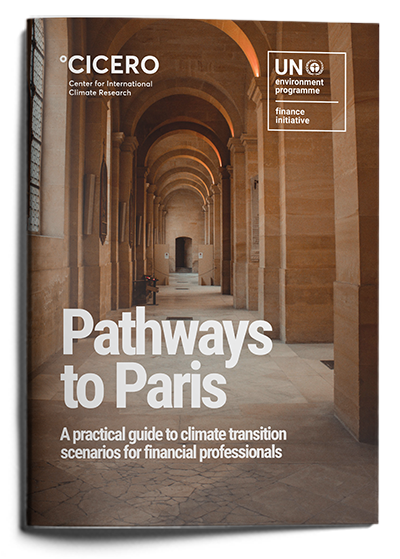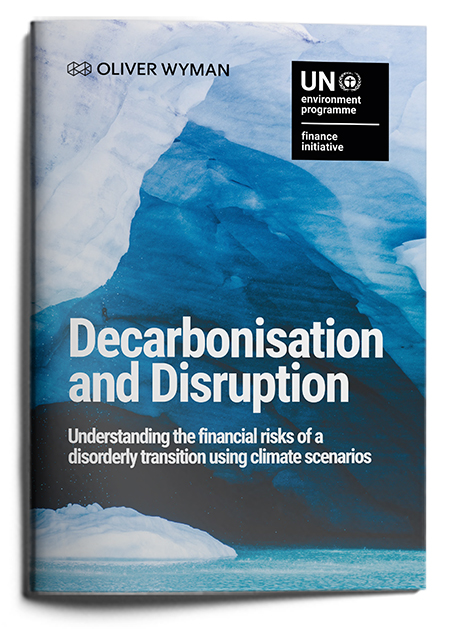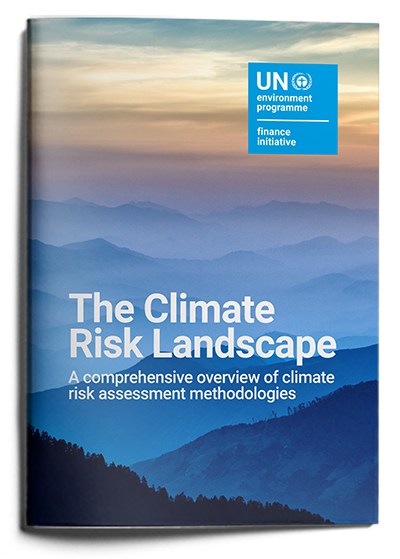Geneva, 17 February 2021 – Transition risk poses a significant near-term threat to the economy. This is one of the findings released today in the latest set of three UNEP Finance Initiative reports on climate risk management tools for financial institutions. The latest guidance is the result of a leading-edge project that convened 39 banks to pilot the recommendations of the Task Force on Climate-related Financial Disclosures (TCFD) building on previous UNEP Finance Initiative work. The package of reports also includes guidance on understanding how the impacts of climate change and the low-energy transition may impact our society and economy and an overview of the various tools and analytics available, as well as the potential technological and regulatory developments that may shape climate risk tools in the future.
 |
 |
 |
Climate scenario analysis is a key tool in measuring and managing climate risks. Climate scenarios produced by Integrated Assessment Models (IAMs) are increasingly being used by financial institutions to identify and assess climate risks. UNEP FI’s report, ‘Pathways to Paris’ is a practical guide for financial practitioners looking to understand and apply climate scenarios. Co-authored with the Center for International Climate Research (CICERO), a world-renowned research institution on climate and climate finance, the report examines the driving assumptions and sectoral coverage of the models used to produce climate scenarios, as well as the benefits and limitations of using these pathways. As the report argues, deeper collaboration and dialogue between financial institutions and scenario developers is essential to linking climate-related risk drivers to financial impacts. Over the course of the past year, UNEP FI has piloted its transition risk methodology with 39 banks. This paper outlines the lessons learned and a series of recommendations for enhancing the development and application of IAMs by financial institutions. Reflecting these views, a North American bank explained that greater granularity, additional consideration of sectoral dynamics, and shorter time-horizons would help financial institutions more effectively use these scenarios. In CaixaBank’s case study, they highlighted a need for greater transparency in the models’ “underlying assumptions” and the treatment of “reputational risks” and “stranded assets,” within the scenarios.
‘Decarbonisation and Disruption’ highlights the ways in which many sectors are exposed to transition risk. If not properly managed, a disorderly transition could have major ramifications for financial stability. Financial institutions need to not only prepare for the transition along with their counterparties but must have the right tools for risk assessment. Insert example from case study here if poss. This paper was supported with analysis from Oliver Wyman, a leading global management consultancy with deep risk expertise. The paper includes bank case studies that affirm greater economic risks associated with disorderly transition scenarios compared with orderly transition scenarios. Banco Bradesco’s case study highlighted the usefulness of the assessment exercise, stating that “transition risk analysis tools are important allies to identify subsectors that are most resilient to policies aimed at a low carbon economy, as well as those that are most exposed to these risks.”
There is a burgeoning market for physical and transition risk tools which may be difficult to navigate. UNEP FI’s report, ‘The Climate Risk Landscape’ provides an overview of the various tools and analytics available, including an assessment of their key characteristics. The report also looks at the potential technological and regulatory developments that will shape climate risk tools over the coming years. In comparing the methodologies and coverage across tools, UNEP FI offers financial users a view of the relative benefits and limitations of each approach.
Reflecting on the guidance and experiences showcased in the two reports, UNEP FI Head, Eric Usher said, “as these scenario reports indicate, deeper collaboration and dialogue between scenario developers and financial practitioners is essential for linking climate-related risk drivers to financial impacts. Over the past year, UNEP FI has repeatedly brought together these parties (along with regulators and supervisors) to support the adoption of climate scenarios in financial decision-making.”
These three reports on climate risk analysis complement previous guidance on this topic which also covered climate risk disclosure practices as well as high-level transition-risk heatmapping and sectoral analysis.
In 2021, UNEP FI launched its latest TCFD programmes for banks and investors, building on the key learnings and achievements of prior pilots. These new programmes will bring new joiners up to speed on the fundamentals of climate risk assessment, while exploring such topics as climate scenario analysis, integrating physical and transition risk analysis and road-testing some of the commercially available climate risk tools identified in ‘The Climate Risk Landscape’. By leveraging the convening power of the United Nations, UNEP FI’s TCFD programme will engage regulators, climate experts, and financial practitioners to empower the financial sector to manage its climate risks and play a positive role in the low-carbon transition.
Further Resources
Download a copy of ‘Decarbonisation and Disruption’
Download a copy of ‘Pathways to Paris’
Download a copy of ‘The Climate Risk Landscape’
Notes to Editors
About UNEP FI’s TCFD Programmes for banks, insurers and investors
The Task Force on Climate-Related Financial Disclosures (TCFD) was created in 2015 by the Financial Stability Board (FSB) to develop consistent climate-related financial risk disclosures for use by companies, banks, and investors in providing information to stakeholders. Increasing the amount of reliable information on financial institutions’ exposure to climate-related risks and opportunities will strengthen the stability of the financial system, contribute to greater understanding of climate risks and facilitate financing the transition to a more stable and sustainable economy.
Following the publication of the final recommendations by FSB’s TCFD in June 2017, UNEP FI began a series of ‘TCFD Pilot Projects’ for banks, investors, and insurers. Participants in these pilots explored physical and transition risks (and litigation risks for insurers) and also pioneered practical approaches for evaluating these risks using climate scenario analyses. Almost 100 financial institutions (banks, investors, and insurers) from all around the world have participated in these pilots. These institutions have been supported by nearly a dozen technical partners from climate modelers to climate risk experts.
These experiences have allowed UNEP FI to take a leadership role in developing good practices regarding climate risk in the financial sector. The pilot programmes have created numerous tools, frameworks, and guides to empower both participating institutions and those throughout the financial industry to better manage and disclose their climate risks.
By systematically engaging global stakeholders, UNEP FI’s newest TCFD programmes (starting Q1 2021) will help financial institutions add depth, granularity, and nuance to their climate risk assessments, consolidate best practices in climate risk management, and help standardize climate disclosures across the industry.
Read more about UNEP FI’s work implementing the TCFD Recommendations.
About UNEP FI’s collaborating partners
CICERO is Norway’s foremost institute for interdisciplinary climate research. CICERO delivers new insights that help address the climate challenge and strengthen international climate cooperation by predicting and researching society’s climate challenges. They are a globally recognized leader in assessing climate transition scenarios and exploring the implications of climate on finance and society.
Oliver Wyman is a leading global management consultancy. The firm combines deep industry knowledge with specialized capabilities in strategy, operations, risk management, and organization transformation. Oliver Wyman has been a leader in climate risk assessment, working with UNEP FI on its Phase I TCFD Programme for Banks and helping clients around the world to address physical and transition risks.


